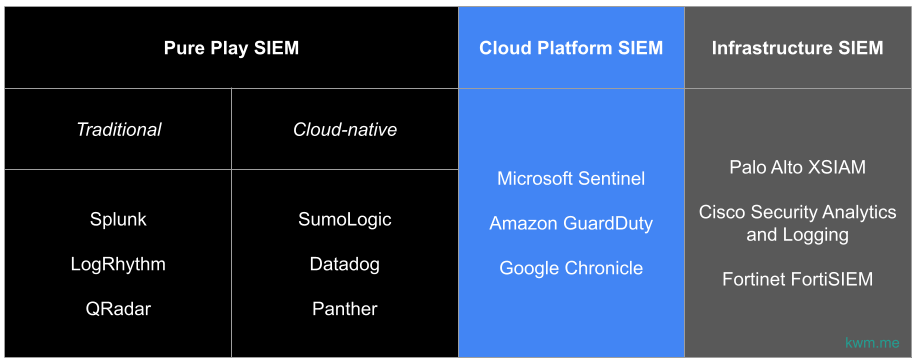Multicloud, and multiSIEM
tl;dr
- Many companies of even modest size are multicloud
- Every major cloud platform and security vendor has a SIEM or is building one
- Because of this, an increasing percentage of companies are now “multiSIEM”
- MultiSIEM is more of a situation we find ourselves in than a strategy
- All SIEM-alike solutions—from narrower log aggregators like XDR, to traditional SIEMs, to newer data lake solutions that better balance scale, cost, and analytical capabilities—are all on a collision course
We are all multicloud
Early on, it used to be the case that we talked about multicloud like “build the same app and deploy it to multiple providers.” In practice, virtually no one does this. The reality is more like:
- We use Google Workspace for email and productivity, and AWS for production.
- We use Microsoft 365 for email and productivity, and Google Cloud for production.
- We use AWS WorkMail for . . . kidding, no one uses the AWS productivity stuff outside of AWS
- Some variant of the above
And an obviously common pattern specific to Microsoft is the Hybrid Cloud, which is a mix of Microsoft cloud and on-premise services.
We aren’t reimplementing the same solution across multiple cloud providers. We’re using the right cloud provider for the right job.
A consequence of this multicloud pattern for cybersecurity practitioners is that we’re often dealing with some overlapping data types (e.g., identity) across cloud providers, but then we’re also dealing with many unique, service-specific data types.
Multicloud? MultiSIEM.
 Above graphic is illustrative, not comprehensive.
Above graphic is illustrative, not comprehensive.
A good number of organizations already identified a need to collect data from a wide variety of systems, and so they’ve adopted one of the handful of pure-play SIEM solutions:
- Splunk
- QRadar
- Elastic Security
- LogRhythm
So, that’s one SIEM.
Then, over time, every major cloud platform provider (and, most major enterprise technology providers) established the pattern of building or acquiring a SIEM, sending all of their native data sources into it, and of course supporting just enough third-party services to make it appealing to some pure-play SIEM customers:
- AWS introduced GuardDuty
- Microsoft introduced Sentinel
- Google did the weird boomerang maneuver with Chronicle (now Google Security Operations SIEM?)
For many organizations, that’s at least two SIEM solutions.
If you already have a pure play SIEM + Microsoft 365 + AWS for production, you might have three SIEMs now, which makes you a true collector.
This is to say nothing of the various log aggregators, like Amazon’s CloudTrail, Security Lake, and numerous other SIEM-adjacent external security services, Google’s Cloud Logging for basic log aggregation, and other solutions like them. These aren’t SIEM per se, but are yet another consideration when it comes to data flows, and thus security investigation workflows.
The cats and dogs of infrastructure
For organizations with on-premise, remote access, or data center infrastructure, they also get to figure out what to do with the massive amount of data generated by these technologies:
- Palo Alto’s XSIAM
- Cisco’s Security Analytics and Logging
- Fortinet’s FortiSIEM
At the end of the day, the unluckiest of organizations have a few or more SIEM-like solutions, depending on how liberally you count.
Don’t forget about XDR
Then, we have XDR platforms, most of which are EDR or EPP solutions that have expanded the scope of data that they can consume, and so “endpoint” is no longer a useful distinction (thus, “extended”).
And this is to say nothing of MDR and other service providers, some of which have their own platform that functions as a SIEM. In these cases, it’s common for selected features to be exposed only to the vendor’s team, while a subset of features are exposed to customers.
From an evolutionary standpoint, XDR platforms are most directly on a collision course with SIEM, which tracks with major platform providers’ roadmaps.
Security platforms and log aggregators on a collision course
Most organizations large, mature, or crazy enough to own a traditional SIEM now have at least two, perhaps more solutions that provide increasingly overlapping functionality. And they have them not because it’s their desire of strategy, but because these various points of aggregation exist and oftentimes the provider’s logs end up in them by default.
There’s a logical desire to collect defensive telemetry and other log data in the fewest number of places, to optimize not only for cost but also for our attention, as we then need to build analytics, perform investigations, and respond to threats. But there’s also a cost to getting data from one place to another, and as we push for more observability, it can quickly run counter to consolidation (e.g., moving all of your Amazon logs to Microsoft or vice versa can incur massive transit costs).
It’s hard to see how this can consolidate in the traditional sense, and the most likely path is that expansive enterprise security teams, including outsourced security operations providers, become adept at minimizing overlap amongst data flows (read: transit and storage costs) and analytics. We’ll figure out how to aggregate the bulk of a given provider’s logs in their native log aggregator, and siphon off a subset to data lakes and/or SIEM platforms based on a combination of cost factors and operational use cases.
Much like we’ve learned to live with multicloud, we’ll learn how to optimize and live with multiSIEM.
